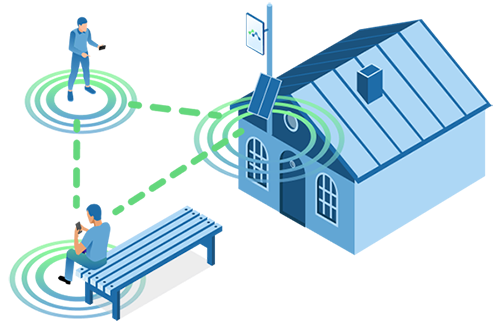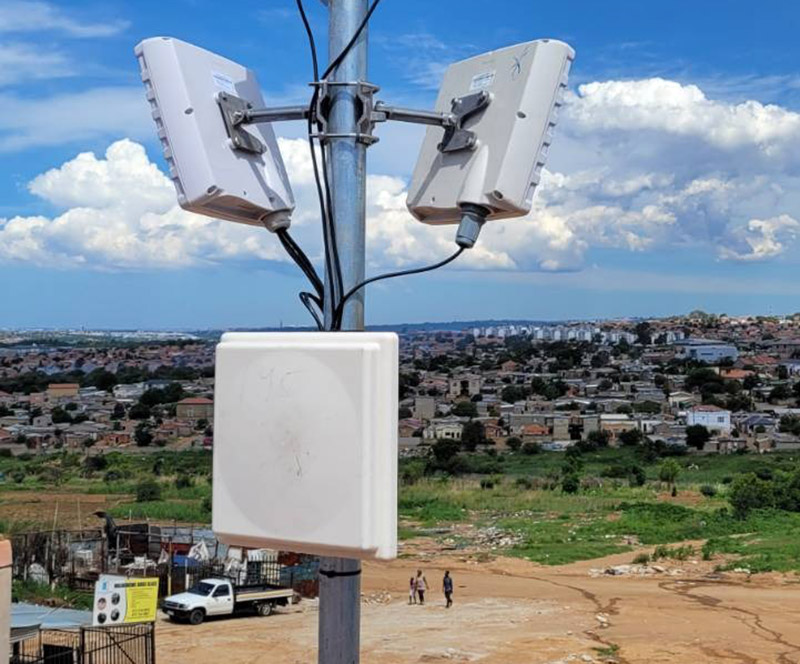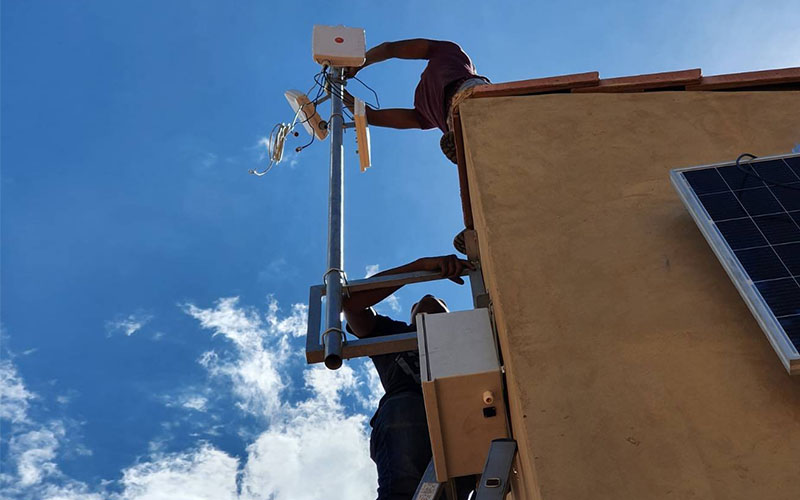Community network last mile delivery project

A suburban area of Johannesburg, South Africa, was constructed as a housing solution for the low-income population. However, despite its residential structures, the region significantly lacked essential infrastructure – primarily, stable internet connectivity.
The challenge was evident: how to achieve dependable and affordable last mile internet delivery in the neighborhood. A system was envisioned that would bridge this gap without extensive infrastructure like laying out cables and high costs for the users. That’s where mesh came into the picture.
The solution is ingeniously simple yet effective. They tap into fiber connectivity available at local hubs like sports bars or schools. Using directed antennas, long-range connections are established, but in a very narrow, directed manner between specific points, spanning up to 20 kilometers.
However, to cover the actual local area, Meshmerize steps in with the mesh network.
installed
by February 2024
than fibre connectivity
The Solution: It has been specifically designed as a last-mile wireless broadband solution tailored for high-density low-to-middle income communities. By leveraging a novel and patented radio antenna wireless system, it can provide high-speed internet to both fixed and mobile users living in densely populated residential areas.
Antenna Design: The antennas, an integral part of the system, are meticulously optimized for both outdoor and indoor router connectivity without necessitating an externally mounted CPE. They possess a flexible mechanical tilt feature, allowing adjustments between 0° and ±15°. Additionally, users have the liberty to rotate these antennas anywhere from 0° to 360°, offering extensive coverage customization.
Power System: Powering this network is a low-profile WiFi access node that operates on solar energy, backed by a robust lithium-ion phosphate battery. This battery stands out for its quick recharge capability, ensuring that the system remains operational for over four days even in the absence of direct sunlight. Complementing this is a dedicated power unit embedded with a control board, engineered specifically for autonomous remote solar management, ensuring consistent performance and minimal manual intervention.
Mesh Access Points: Once the directed antenna brings the internet connection to a central location, the actual distribution within the community is handled by mesh access points. Each sector of the neighborhood (comprising 40-50 houses) is covered by around 10 of these mesh access points. A total of 180 access points are installed to cover the sectors.

Meshmerize's Integral Role

Meshmerize is at the heart of the project with its self-healing and decentralized nature, bringing the internet to each of the users. Here’s why Meshmerize was a great fit for this use case:
Quick Setup: Unlike traditional methods that require extensive planning and infrastructure, mesh networks can be deployed rapidly, adapting to unforeseen challenges on the go. Planning is super flexible, as the devices can be placed without relying on a single, unique location. This solves potential problems that would occur with building infrastructure changes or lack of approval from homeowners to have the devices placed on their homes.
Self-healing: Even if an access point faces disruptions, the mesh design ensures that data finds an alternate path, guaranteeing uninterrupted service. The resilience of Meshmerize comes especially useful in cases of environmental issues such as strong winds or other circumstances that might damage the hardware.
Cost-Effective: Cosmo City deployment has proven to be about 40-50% cheaper than fibre based solutions. It’s simple. Since cables don’t have to lead to every doorstep and not every house has to have networking hardware, internet access for the provider and the end user is way more affordable.
Our mesh network management tool Hive plays a pivotal role in overseeing the vast mesh network, ensuring consistent configuration across hundreds of nodes. This centralized management system is instrumental in allocating different channels to various parts of the network, significantly reducing interference and ensuring smooth data transmission.
With Hive‘s oversight, potential issues can be proactively identified and addressed, guaranteeing that the network maintains its high-performance standards. In such an environment, Hive’s contribution to Meshmerize’s deployment cannot be understated.


Power Grid Independence
Power outages and irregular electricity supply are common woes in such areas. The system is designed to be independent of the power grid, ensuring constant connectivity regardless of external power fluctuations. Solar panel found on each of the access points, equipped with a lithium battery, ensures this self-sustenance.
Cable-free connectivity
Utilizing the power of the sun through solar panels eliminates the need for any cables in its network infrastructure. This means that the common concerns of cable damage due to construction or other activities are entirely bypassed. A cable-free network ensures a consistent and unbroken connection, reducing vulnerabilities and maintenance needs, and further exemplifying the robustness and adaptability of the network.
Maintenance and Local Empowerment
The system is designed so local residents, with minimal training, can perform basic maintenance tasks, ensuring the network’s upkeep without the need for specialized personnel. Empowering locals to partake in the maintenance fosters community involvement and creates a win-win situation where local maintainers receive benefits like free internet for their contributions.
Beyond residential areas like this one, the potential of mesh in last mile delivery projects is vast. It can be a game-changer in rural regions, disaster-struck zones where infrastructure is compromised, temporary setups like events or festivals, and even in dense urban settings where laying additional infrastructure is either costly or impractical.
Replicability and Future Ambitions
The success of this project is just the tip of the iceberg. The community network design, with its emphasis on mesh connectivity and power autonomy, offers a flexible and adaptable solution that can be easily replicated in diverse environments. The system’s resilience and scalability make it a universal solution for last-mile delivery challenges in various settings around the globe.


- Meshmerize enables stable internet connectivity for a community network, aiming for 4,000 users by the end of 2023.
- Mesh networks can be swiftly installed, adapting to unforeseen challenges without relying on specific locations or excessive infrastructure.
- With its self-healing nature, even if an access point is disrupted, Meshmerize ensures uninterrupted service, navigating environmental challenges effectively.
- The deployment is 40-50% cheaper than traditional fibre solutions, benefiting both providers and end-users.
- Hive ensures smooth data transmission by managing the mesh network, allocating channels, and reducing interference, making Meshmerize’s deployment robust.
- Beyond just providing internet, the network fosters community involvement, allowing local residents to contribute to the network’s maintenance.





